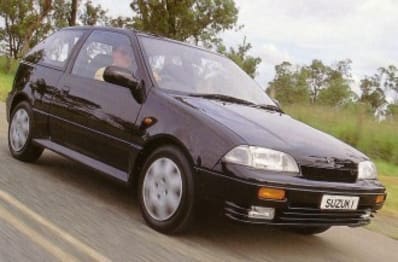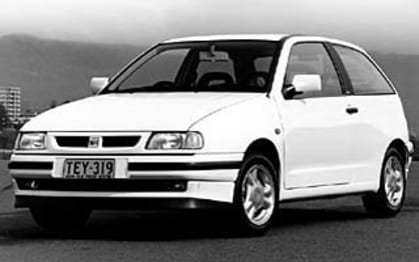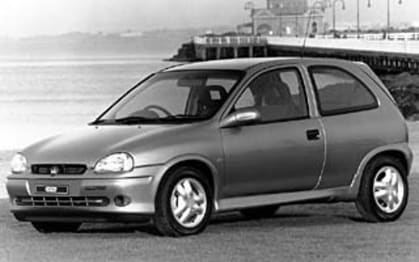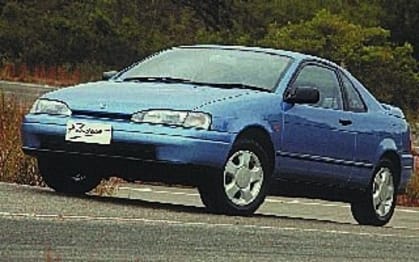
Used Suzuki Swift review: 1989-2000
- Suzuki Swift
- Suzuki Swift 1995
- Suzuki Swift 1989
- Suzuki Swift 1990
- Suzuki Swift 1991
- Suzuki Swift 1992
- Suzuki Swift 1993
- Suzuki Swift 1994
- Suzuki Swift 1996
- Suzuki Swift 1997
- Suzuki Swift 1998
- Suzuki Swift 1999
- Suzuki Swift 2000
- Suzuki Swift Reviews
- Suzuki Reviews
- Suzuki Coupe Range
- Suzuki Hatchback Range
- Coupe
- Hatchback
- Suzuki
- Used Car Reviews
- Buying tips

Back in 1989 when Suzuki launched the Swift it was virtually alone in the light hatch segment. There were lots of small cars at the time, but the Swift was a light little hatch that was smaller again and almost formed its own market segment.
Suzuki has never had much more than a toehold in the Australian market despite having a reputation for solid engineering.
The company is better known for its motorcycles, while its cars have been quirky with a strong connection to their two-wheel cousins in an engineering sense.
It’s that motorcycle connection that helps explain the nature of the company’s cars, which have always been light with power delivered by small jewel-like engines that love to be revved.
The Swift GTi was the sporty version of the Swift hatch. It was a pocket rocket that won a following with younger drivers who came to admire its giant-killing capacity when pitted against bigger and much more powerful cars in rallying and on the racetrack.
MODEL WATCH
The SF Swift first saw light of day here in 1989. It was a cute little car offered as a three-door or five-door hatch, and while it was a small car it was really a size below most of the other small cars on the market.
Its formula, one Suzuki seemed to adopt from its experience in building motorcycles, was of a light car with a free-revving engine that resulted in an impressive power-to-weight ratio.
Japanese motorcycle manufacturers long understood the value of the power-to-weight formula as a way of achieving high performance without the need for a big engine.
In that sense the Swift was a motorcycle on four wheels, but it’s that same philosophy that presents problems in the used car scene.
The GTi was the sporty model in the Swift range. It came only as a three-door hatch and boasted more thrills than frills.
It was dressed up with body-coloured bumpers that gave it a sporty look, but other than that there were few cosmetic changes to the basic Swift.
Weighing a mere 830 kg fully dressed the GTi didn’t need much in the way of grunt to get it moving swiftly.
Power was provided by a diminutive 1.3-litre double overhead camshaft four-cylinder engine that was able to generate 74 kW when at its angriest, which was when it was spinning at 6450 revs. Maximum torque was a tiny 113 Nm at 4950 revs.
A five-speed manual gearbox processed the power before sending it on to the front wheels for transfer to the road.
To get the best out of it you had to clamp your right foot to the floor and keep it there. Soft peddling would get you nowhere.
In fact, even when you did rev it the result was hardly likely to take your breath away. Under the pressure of a stopwatch a Swift GTi would still take more than 17 seconds to cover the standing 400-metre sprint.
The reality was that the GTi wasn’t that quick in a straight line, but that wasn’t its strength. The GTi came into its own when the road twisted and turned, its low weight helped make it nimble, which was the real key to its appeal.
While it handled well its suspension was firm and its ride too hard to appeal to anyone but the young enthusiast.
The list of standard features was quite short, consisting of fog lamps, power windows and mirrors, sports seats and trim, and four-speaker radio-cassette sound.
IN THE SHOP
The GTi’s light construction, and the real chance they have been driven hard and fast by enthusiasts, means they need be approached with caution. Look for doors that have sagged, hatches that don’t quite fit the body openings properly, and general squeaks and rattles.
Many have been used in competition over the years so look for odd holes and modifications to fit safety equipment like fire extinguishers, racing harnesses and roll cages. Steer clear of any car that appears to have been used in that way.
While the engine is a gem it should be checked thoroughly for wear. Watch for oil smoke from the exhaust, which might indicate worn rings or other deeper internal issues needing attention.
Listen for clicking noises from the front suspension when turning, which suggests the CV joints are worn and need replacing.
Ask for a service record that shows the GTi has been regularly and properly serviced, including regular changes of engine coolant.
IN A CRASH
Light construction, the capacity to go quickly, and a lack of ABS anti-skid brakes and airbags means the GTi doesn’t score highly on the safety scale.
In recent real life crash surveys the Swift has been rated significantly worse than average, not a good report at all.
OWNERS SAY
Henry Chung once owned a 1997 Suzuki Swift GTi and his memory of it was that it was a zippy little hatchback that loved to be revved, but was economical to run, easy to maintain and could be readily modified to increase its performance. But its back seats were cramped and it was prone to sticking tappets, its CV joints wore quickly and blue smoke could be seen occasionally coming from the exhaust.
LOOK FOR
• Rattling engine
• Exhaust smoke
• Ticking front suspension
• Cramped interior
• Body squeaks and rattles
• Poor crash protection
• Agile handling
THE BOTTOM LINE
Hot hatch has seen better days, best to be avoided.
RATING
45/100
Pricing
| Year | Price From | Price To |
|---|---|---|
| 2000 | $1,540 | $4,070 |
| 1999 | $1,540 | $4,070 |
| 1998 | $1,540 | $4,070 |
| 1997 | $1,540 | $4,070 |
| 1996 | $1,540 | $4,070 |
| 1995 | $1,540 | $7,260 |
| 1994 | $1,540 | $6,600 |
| 1993 | $2,310 | $6,160 |
| 1992 | $2,310 | $4,950 |
| 1991 | $2,310 | $7,150 |
| 1990 | $2,640 | $6,930 |
| 1989 | $2,640 | $4,070 |
Pricing guides
Range and Specs
| Vehicle | Specs | Price* | |
|---|---|---|---|
| GA | 1.0L, Leaded, 5 SP MAN | $2,640 – 4,070 | 1989 Suzuki Swift 1989 GA Pricing and Specs |
| GL | 1.0L, Leaded, 3 SP AUTO | $2,640 – 4,070 | 1989 Suzuki Swift 1989 GL Pricing and Specs |
| GLX | 1.6L, ULP, 5 SP MAN | $2,640 – 4,070 | 1989 Suzuki Swift 1989 GLX Pricing and Specs |
| GTI | 1.3L, ULP, 5 SP MAN | $2,640 – 4,070 | 1989 Suzuki Swift 1989 GTI Pricing and Specs |
Other cars to consider
$2,310
Lowest price, based on third party pricing data










